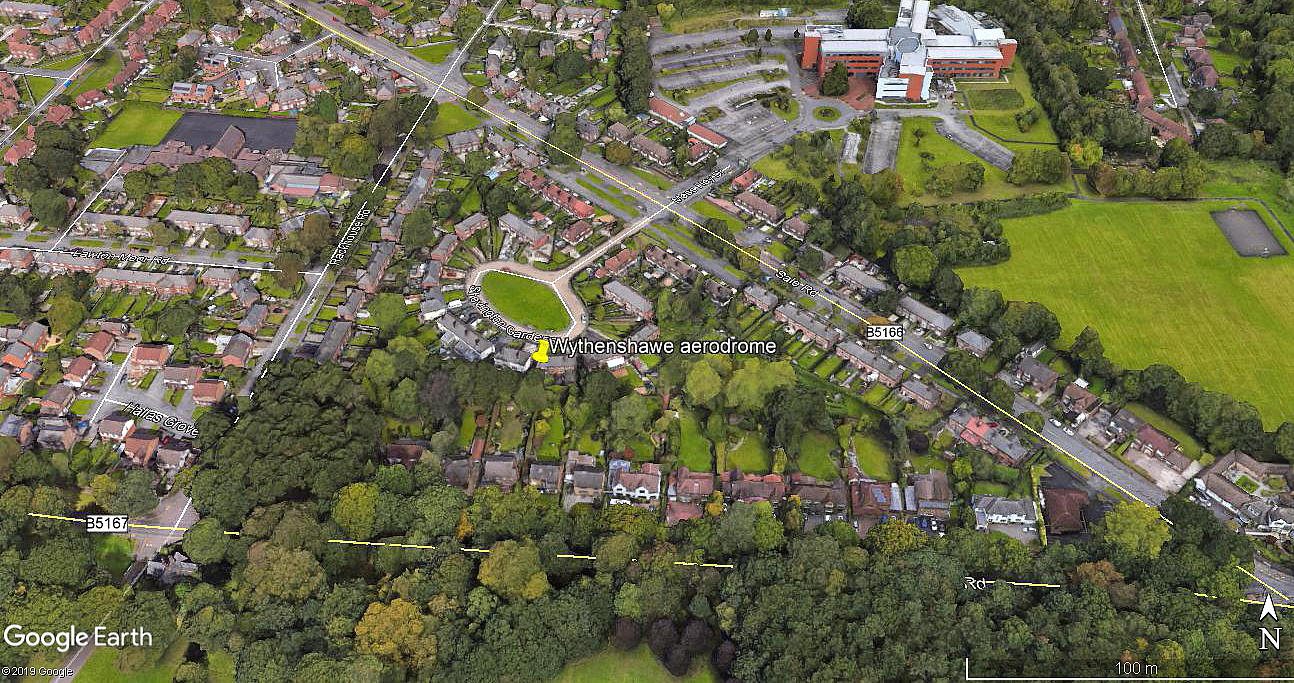Wythenshawe
WYTHENSHAWE: Temporary municipal aerodrome/airport (Aka RACKHOUSE aerodrome)
Note: Both of these pictures were obtained from Google Earth ©
Used by: Northern Air Transport
Location: Now appearing to be a triangular site, with the boundaries of Rackhouse Road to the W, Wythenshawe Road (B5167) to the S and Sale Road (B5166) to the N. Just W of the A5103 Princess Parkway. In 1929 it was a rectangular airfield, the Sale Road being laid down across the site at a later date.
Period of operation: 1929 to 1930 only
NOTES: In April 1929 a new company, Northern Air Transport, took over Berkshire Aviation Tours, and set up operations here before moving to the new Barton Airport in June 1930.
In his magnificent book British Commercial Aircraft, Arthur W.J.G. Ord-Hume has a picture of the Manchester Town Clerk F.E. Warbeck Howell and Alderman R.A.W. Carter, (looking rather apprehensive), seated in the Airco DH.9c G-EBIG owned by Northern Air Transport. They were about to fly down to CROYDON on the 22nd April 1929 to collect the temporary license for WYTHENSHAWE aerodrome. The pilot was Edward Arnold Jones.
Touring the UK with ‘The Great Air Pageant’ one of their featured acts caught my eye. This was when ‘The Flying Marksman’ Colonel M.U. Stard (‘Stiffy’), late of the Pyrenese Camel Corps and recently back from a stint in Neuralgia demonstrated a remarkable knack of shooting at and bursting balloons.
UK AIRPORTS - 1929
By the end of 1929 it seems only eight ‘proper’ municipal airports were operational and other sources claim only four had started operations. These being Manchester/Wythenshawe in May, Nottingham/Tolerton in July, Blackpool/Stanley Park in August and Hull/Hedon in October.
It seems worth pointing out that during this period and even into the mid 1930s or beyond many destinations served by scheduled services, (which we might now assume should be an ‘airport’), were in fact in some cases nothing more than a flattish grass field with a windsock! And I’m talking major English towns here, not a remote Scottish Island. Only some had possibly a tent or wooden hut/shack as a terminal let alone a hangar or fuel! Eh by gum, they’se were hardy folks in them days.
BY COMPARISON
By comparison many private airfields/farm airstrips today have far superior facilities plus a larger landing area…in fact invariably a prepared grass runway or two laid out. I suspect though, that although being greatly impressed by the facilities those early aviators would have considered the idea of having set runways as being a very foolish idea by and large, although big airports such as Croydon did have them, very sensibly they invariably landed and took-off into wind as far as possible. In fact the very idea of having precisely defined runways, (although many grass runways were marked out but often subject to change), really didn’t really exist until WW2 when hard runways were required for increasingly heavy bombers especially.
Prior to that many grass Landing Grounds often had ‘preferred landing areas’ that were longer or smoother or harder, (sometimes all three), but that’s as far as it went by and large. The idea of specifically preparing a ‘limited area’ or clearly defined grass runway came about mainly in WW.2 when metal track was laid into the grass to enable ‘all-weather’ operations.
We'd love to hear from you, so please scroll down to leave a comment!
Leave a comment ...
Copyright (c) UK Airfield Guide

















